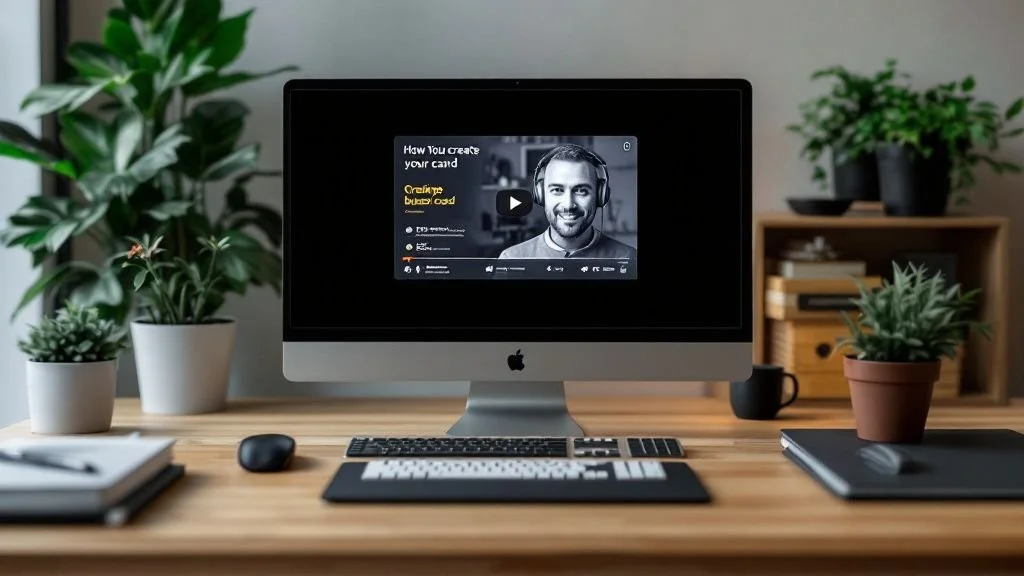The Power of Video Business Cards
Key Takeaways
- Video business cards offer a dynamic way to showcase your professional brand through engaging visuals.
- They allow for easy sharing and enhance connectivity in the digital networking landscape.
- Video business cards are expected to evolve with features like augmented reality and interactivity.
- Creating a video business card involves delivering a clear message with quality visuals and sound.
- The preference for video content makes video business cards a strategic tool in modern networking.
The rise of video business cards is transforming how you present yourself professionally. Unlike traditional methods, this innovative tool breathes life into your introduction, offering a dynamic and immersive experience. As you embrace this digital evolution, the video business card stands out, allowing recipients to connect with your personality and brand instantly. Picture this: a brief, engaging video showcasing your skills, achievements, and services—capturing attention instantaneously. With a digital business card, you embed your video seamlessly into your professional profile, expanding your reach and enhancing memorability. This engaging format not only conveys information but captivates viewers, setting you apart in a crowded digital landscape.
What is a Video Business Card
One of the most frequently asked questions about video business cards is "What exactly is a video business card?" A video business card is an innovative twist on the traditional business card, leveraging video technology to deliver a more engaging and personal representation of who you are and what you offer. It seamlessly combines the accessibility of digital communication with the impact of visual storytelling.
A video business card typically contains a short video clip, often around 60 seconds, that captures your personal or professional story. It highlights your key skills, values, and message, creating a memorable first impression. When you share a digital business card that includes a video, you allow your audience to see and hear you, forging a deeper connection immediately.
Incorporating video into your business card offers several advantages. It allows you to convey more information in a shorter amount of time compared to text, making it perfect for today's fast-paced digital environment. As a visual medium, it enhances recall and engagement, which are crucial when networking or trying to stand out in competitive industries.
For businesses and individuals alike, video business cards serve as a dynamic way to showcase uniqueness. Whether networking online or in-person, this format breaks traditional barriers, letting your personality and professionalism shine through captivating videos.
Benefits of Using Video Business Cards
Embracing video business cards brings multiple benefits, enhancing the way you communicate your professional identity. Foremost, it offers a captivating and dynamic way to capture attention. Unlike traditional business cards, video content can convey your passion and personality, leaving a lasting impression on viewers. This tool personalizes your introduction, making connections feel more authentic and engaging.
Another key advantage is the ease of sharing. Digital business cards can be distributed effortlessly through email, social media, and messaging apps, reaching broader audiences efficiently. With just a single link, you can deliver your video business card to potential clients or partners, allowing for immediate impression-building. This accessibility makes it an ideal choice for expanding your professional network.
Looking ahead, video business cards are expected to evolve with technological advancements. Enhanced features like interactive elements, augmented reality, and integration with other digital platforms will likely become standard. As technology progresses, the personalization and impact of video business cards will only increase, making them an essential tool in any professional toolkit.
Harnessing the power of video business cards not only enhances your professional outreach but also aligns you with future market trends. In a world increasingly leaning towards digital engagement, leveraging video formats can provide a unique edge, setting you apart from the competition.
How to Create Your Own Video Business Card
Creating your own video business card starts by outlining the key message you want to convey. Begin with a clear script that highlights your strengths, services, and personality. Keep it concise, aiming for a video length of about 60 to 90 seconds. Use a conversational tone to foster a personal connection, ensuring your potential contacts feel engaged and informed about what makes you unique.
The production phase involves selecting the right tools and settings. Choose a well-lit space and use a high-quality camera or smartphone for crisp visuals. Practice your delivery to ensure confidence and clarity. You can enhance the video with subtle background music and on-screen text to emphasize key points. Editing software like Adobe Premiere Rush or iMovie can be great for refining the final video.
The current trend in video business cards shows a surge in popularity due to their unique engagement and shareability. People are increasingly seeking interactive and visually appealing introductions. Incorporating creative elements such as animation or personal branding can significantly increase its impact. As digital communication dominates the professional sphere, mastering the art of video business cards offers a competitive advantage, reflecting a modern approach in personal branding.
Best Practices for Video Business Cards
To ensure your video business card resonates effectively, focus on delivering a concise, authentic message. Prioritize clarity and brevity by emphasizing your unique selling points within the brief video duration. Engage viewers from the start with a compelling introduction and maintain a consistent tone that reflects your professional persona. This approach ensures that your business card remains impactful and memorable.
Visual and audio elements play a significant role in the overall effectiveness of your video business card. Ensure high-quality visuals and clear audio, as any discrepancies can detract from your message. Good lighting and a quiet recording environment contribute to a professional finish. Subtle background music can enhance the presentation but ensure it doesn’t overshadow your voice.
According to recent studies, the human brain processes visual information 60,000 times faster than text. This scientific finding explains how video business cards can more effectively capture and retain attention compared to traditional static cards. By leveraging this cognitive preference for visuals, you can create a lasting impression, facilitating better recall and engagement from your audience.
Incorporating a call to action in your video business card is essential. Encourage viewers to connect or explore further, guiding them towards your website or social media profiles. This step maximizes the potential of your digital business card, transforming passive viewers into active connections, while reinforcing your professional network expansion goals.
The Future of Networking with Video Business Cards
The digital revolution is reshaping how you network, with video business cards leading the charge. This modern tool provides a dynamic alternative to traditional business cards, capitalizing on visual engagement and interactivity. As virtual and remote interactions become commonplace, video business cards are well-suited to bridge gaps, offering a personal touch in the digital landscape. They seamlessly integrate visuals and information, ensuring your introduction is both impactful and memorable.
Advancements in technology are continuously enhancing the capabilities of video business cards. Features like augmented reality, clickable links, and customizable templates allow you to creative tailor the content, engaging your audience effectively. These innovations provide opportunities for dynamic storytelling that static cards cannot match, elevating professional introductions to new heights of personalization and innovation in the networking realm.
Did you know? 72% of consumers prefer to learn about a product or service through video content, according to a study by HubSpot. This statistic underlines the growing importance of video in communication and its potential to dominate networking strategies. Video business cards, therefore, present a strategic advantage by aligning with these consumer preferences, facilitating more effective connections with potential clients or collaborators.
In the future, the adoption of video business cards is expected to rise alongside advancements in digital networking solutions. As platforms and industries continue to integrate video technology, those who proactively embrace video business cards will find themselves ahead of the curve, equipped with a versatile tool that not only reflects their brand but also enhances their networking efforts in today's fast-evolving digital landscape.
Frequently Asked Questions
What is a video business card?
A video business card is a digital card that uses video content to present your professional identity through a dynamic and engaging format.
How long should a video business card be?
Typically, a video business card should be around 60 to 90 seconds to maintain viewer engagement and convey essential information effectively.
Can I share my video business card on social media?
Yes, video business cards can be easily shared on social media platforms, email, and instant messaging apps for broader networking.
What equipment do I need to create a video business card?
You will need a good quality camera or smartphone, proper lighting, and video editing software to create a professional-looking video business card.
Are video business cards effective for networking?
Yes, they are effective as they capture attention quickly and help establish more personal connections in a digital networking environment.



